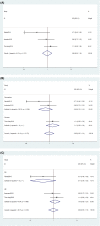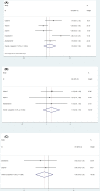The association between RANK, RANKL and OPG gene polymorphisms and the risk of rheumatoid arthritis: a case-controlled study and meta-analysis
- PMID: 31209146
- PMCID: PMC6597846
- DOI: 10.1042/BSR20182356
The association between RANK, RANKL and OPG gene polymorphisms and the risk of rheumatoid arthritis: a case-controlled study and meta-analysis
Abstract
The receptor activator of nuclear factor-κB (RANK) and the osteoprotegerin (OPG) cascade system have been reported to be essential in osteoclastogenesis. In recent years, several studies have investigated the association between polymorphisms of RANK, its ligand RANKL and OPG genes and the risk of rheumatoid arthritis (RA) in different populations. However, the results arising from these studies were conflicting. To determine the association between RANK, RANKL and OPG gene polymorphisms and the risk of RA. We conducted a hospital-based case-controlled study in Changzhou with 574 RA cases and 804 controls. The genotyping of RANK gene rs1805034 polymorphism was conducted by single base extension combined with matrix-assisted laser desorption/ionization time of flight mass spectrometry (MALDI-TOF-MS). We also undertook a meta-analysis of the literature referring to polymorphisms of RANK, RANKL and OPG genes and RA risk. This case-controlled study found that the polymorphism in the RANK gene rs1805034 was not related to RA risk. Stratification analyses by sex and age suggested that RANK gene rs1805034 polymorphism was not associated with the risk of RA among groups of male, female, age ≤ 55 and age > 55. Our meta-analysis found that the rs2277438 polymorphism in RANKL gene increased the risk of RA, whereas RANK gene rs1805034, OPG gene rs3102735, OPG gene rs2073618, OPG gene rs3134069 polymorphisms were not related to RA susceptibility. In conclusion, this case-controlled study and meta-analysis indicated that the RANKL gene rs2277438 polymorphism increased the RA risk, and that RANK gene rs1805034, OPG gene rs3102735, OPG gene rs2073618, OPG gene rs3134069 polymorphisms were not related to RA risk.
Keywords: RA; RANK; RANKL; case-controlled study; polymorphism.
© 2019 The Author(s).
Conflict of interest statement
The authors declare that there are no competing interests associated with the manuscript.
Figures



Similar articles
-
Genetic variations in genes encoding RANK, RANKL, and OPG in rheumatoid arthritis: a case-control study.J Rheumatol. 2010 May;37(5):900-4. doi: 10.3899/jrheum.091110. Epub 2010 Mar 15. J Rheumatol. 2010. PMID: 20231205
-
Single nucleotide polymorphism of RANKL and OPG genes may play a role in bone and joint injury in rheumatoid arthritis.Clin Exp Rheumatol. 2014 Sep-Oct;32(5):697-704. Epub 2014 Jul 17. Clin Exp Rheumatol. 2014. PMID: 25068378
-
Association of genetic polymorphisms of RANK, RANKL and OPG with bone mineral density in Chinese peri- and postmenopausal women.Clin Biochem. 2013 Oct;46(15):1493-501. doi: 10.1016/j.clinbiochem.2013.03.011. Epub 2013 Mar 24. Clin Biochem. 2013. PMID: 23531404
-
Receptor activator of nuclear factor-κB ligand (RANKL)/RANK/osteoprotegerin system in bone and other tissues (review).Mol Med Rep. 2015 May;11(5):3212-8. doi: 10.3892/mmr.2015.3152. Epub 2015 Jan 7. Mol Med Rep. 2015. PMID: 25572286 Review.
-
[Genomic approaches to bone and joint diseases. Mutations of RANK, OPG and RANKL genes found in humans].Clin Calcium. 2008 Feb;18(2):202-9. Clin Calcium. 2008. PMID: 18245890 Review. Japanese.
Cited by
-
Genetic Variants in RANK and OPG Could Influence Disease Severity and Bone Remodeling in Patients with Early Arthritis.Life (Basel). 2024 Sep 3;14(9):1109. doi: 10.3390/life14091109. Life (Basel). 2024. PMID: 39337893 Free PMC article.
-
Polymorphisms within the RANK and RANKL Encoding Genes in Patients with Rheumatoid Arthritis: Association with Disease Progression and Effectiveness of the Biological Treatment.Arch Immunol Ther Exp (Warsz). 2020 Aug 19;68(4):24. doi: 10.1007/s00005-020-00590-6. Arch Immunol Ther Exp (Warsz). 2020. PMID: 32815001 Free PMC article.
-
Pathomechanisms of bone loss in rheumatoid arthritis.Front Med (Lausanne). 2022 Aug 17;9:962969. doi: 10.3389/fmed.2022.962969. eCollection 2022. Front Med (Lausanne). 2022. PMID: 36059831 Free PMC article. Review.
-
Protective Effect of TNFRSF11A rs7239667 G > C Gene Polymorphism on Coronary Outcome of Kawasaki Disease in Southern Chinese Population.Front Genet. 2021 Aug 17;12:691282. doi: 10.3389/fgene.2021.691282. eCollection 2021. Front Genet. 2021. PMID: 34484292 Free PMC article.
-
Aptamers for Proteins Associated with Rheumatic Diseases: Progress, Challenges, and Prospects of Diagnostic and Therapeutic Applications.Biomedicines. 2020 Nov 22;8(11):527. doi: 10.3390/biomedicines8110527. Biomedicines. 2020. PMID: 33266394 Free PMC article. Review.
References
Publication types
MeSH terms
Substances
LinkOut - more resources
Full Text Sources
Medical

